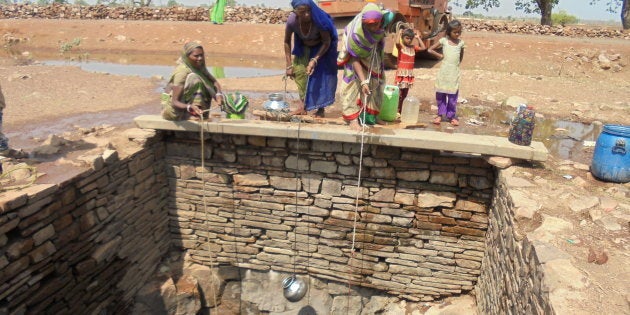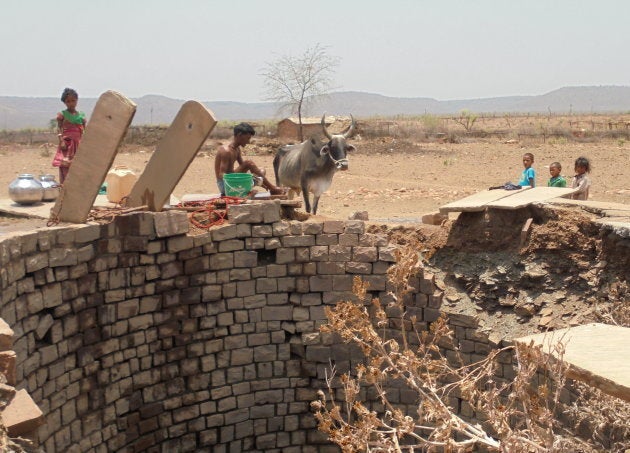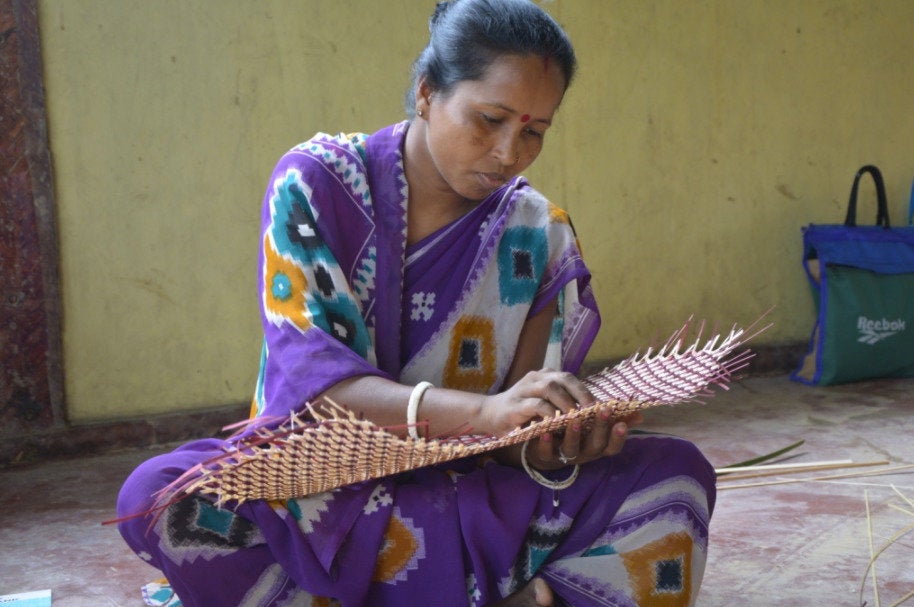
By Shreehari Paliath*
As we bound and leap over lumps of dung and hay, scampering for cover from the rain, only the dry bed of the stream in Kaluthra seems to soak in the moment. Bundelkhand's parched landscape has little to offer to the thirsty, even to members of the Sahariya tribe—its original inhabitants.
With an annual rainfall of 875mm these parts of MP may not seem to be water-stressed. But that depends on who you ask. For the Sahariya it has been a constant struggle...
Listed among the 75 Particularly Vulnerable Tribal Groups in India, the Sahariya constitute nearly 12% of Shivpuri's (Madhya Pradesh) population. Scheduled Tribes (ST) constitute 14.7% of the state's population; the highest in India. Even within the significant ST population in the state, the Sahariya remain highly exploited and marginalised. According to a 2001 Census document, the overall literacy rate of Sahariya was 28.7%, and the female literacy rate was at a mere 15.9%. The technical and non-technical diploma and graduate percentages languished at 0.1% and 0.5% respectively.

Due to their low educational levels, patchy land ownership, and reduced farming opportunities, Sahariya are forced to seek manual labour in nearby states and cities. Nearly 57% of the population was engaged in agricultural labour, according to the 2001 census. The sparse forests, which once offered some respite with their tendu leaves, gondh, mahua and other herbs, have started to dwindle, making survival precarious for the Sahariya. The adivasi community has depended on the forest for its livelihood. On an average, a Sahariya household has two to five bighas of land on which they practice slash and burn farming (locally known as "sur"). With changing times, there has been a shift from traditional crops like kado, kutki and aalo to chickpeas, mustard, groundnut, soyabean etc. The yields are not inspiring. Although patta (a title deed to a property) is in the name of adivasis, land and resources have been generously usurped by other caste groups. Even when the land is in their possession, many pawn it to supplement their meagre income from farm labour. Now, the water situation is pushing them to the brink.
With an annual rainfall of 875mm these parts of Madhya Pradesh may not seem to be water-stressed. But that depends on who you ask. For the Sahariya it has been a constant struggle to ensure quantity and quality. "There was a time when we had to travel nearly 10 kilometres to get water. Some of us would stay on to get work done, while the others would go to fetch water. Its better now," says a villager in Chakrampura. This sense of relief comes from the increased presence of handpumps or wells. As my colleague and I spoke to an all-male congregation, the women, ironically, had to persist with the chore of drawing water from a few nearby wells whose waters were, at best, murky. The "betterment" was yet to reach them.
Although community members are willing to initiate measures to curb a further fall in groundwater levels by implementing protocols and regulations, inactive committees and weak local-level institutions get in the way.
Meanwhile, in an adjacent village dominated by a particular caste group, the situation was better, or so it seemed. They could afford to drill borewells and extract as much water as was possible. Rampant digging of borewells by wealthier castes and communities, many of whom have annexed adivasi land, is leading to a dramatic decline in the water table in the region. The water source on which this Sahariya village in Chakrampura largely depends fills up only when there is water in the nearby pond. As soon as this pond fills up, it is drained by the wealthier communities for their agricultural needs, forcing the Sahariya to fend for themselves. For many, the wait to fill a couple of pots of water lingers far into the night.
According to elders in Kaluthra, the rainfall pattern has changed drastically over the years. It used to be dispersed over three to four months. Lately, the same intensity of rainfall is concentrated within a month, inundating the villages not just with water, but also chaos. This has forced a change in agricultural practices and the communities' relationship with water. Kaluthra's stream carried waters from many smaller ones during the rainy season. Over the years, increased construction and deforestation has lead to a reduction in its capacity. Although community members are willing to initiate measures to curb a further fall in groundwater levels by implementing protocols and regulations, inactive committees and weak local-level institutions get in the way. Yet, under the leadership and initiative of women the village in Kaluthra has managed to protect a pond just for their livestock.
The women, who are usually the best judges on the state of water in a village, understand the circumstance better. All of them know of the one well in the village that they can rely on.
In another village in Ranipura, electrification has expanded the area under cultivation. The village has seen an increase in harvest. Though there are no borewells in the village, the regularised supply of electricity has allowed for pumps to be installed in some of the wells. Agriculture is focused on the kharif season. This would mean that a falling water table and irregular rainfall will severely affect the prospects of growth and development for the community.
During our conversations, the men contest the probability of an impending scarcity of water. It is not easy to imagine water below the ground. It is tougher to imagine it as finite. The women, who are usually the best judges on the state of water in a village, understand the circumstance better. All of them know of the one well in the village that they can rely on. For, who else would know the quality of water in the well at the peak of summer? Its effect can be seen on the health of their children whose responsibility falls solely on them. It was their nods and murmurs of concurrence, under their veils, on the state of water that offered a glimmer of hope towards sustainable management of water. The challenge lies in making the community comprehend the necessity to conserve groundwater and ensure perennial availability of water in these vulnerable habitations. For the Sahariya it is what they must do to not only survive but thrive.
*Shreehari Paliath can be reached at shreehari@arghyam.org
The opinions expressed in this post are the personal views of the author. They do not necessarily reflect the views of HuffPost India. Any omissions or errors are the author's and HuffPost India does not assume any liability or responsibility for them.
